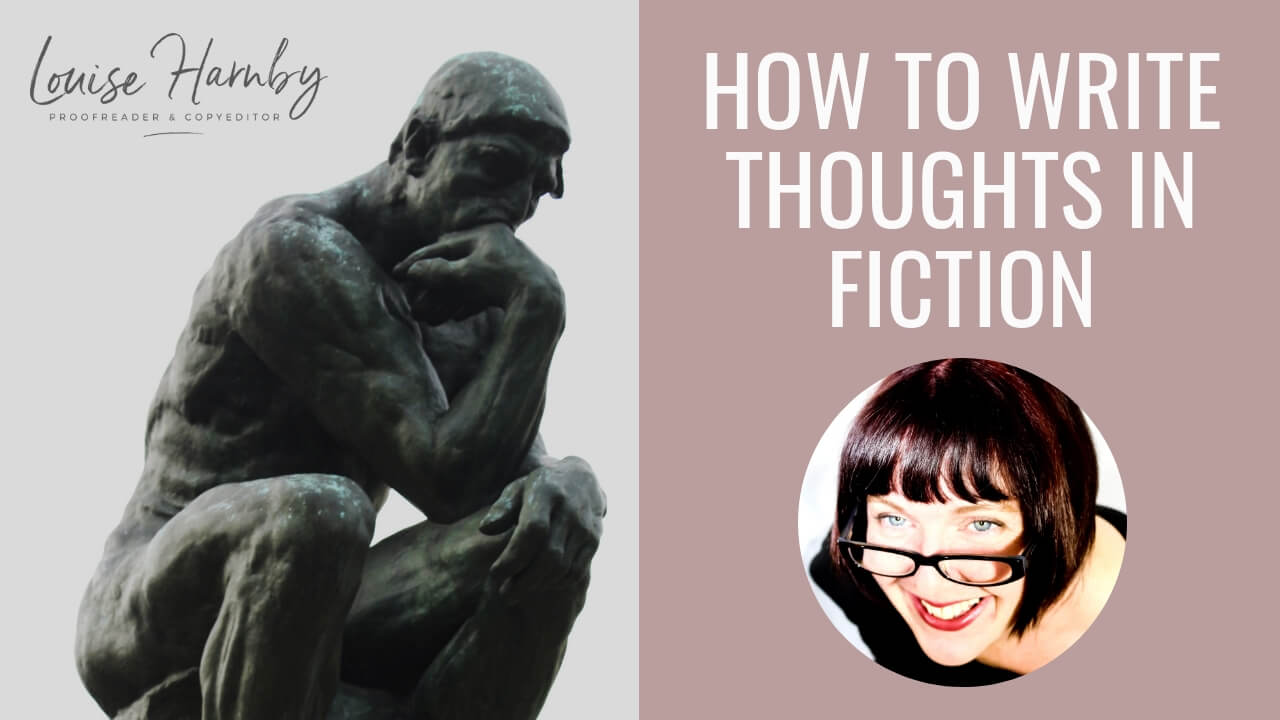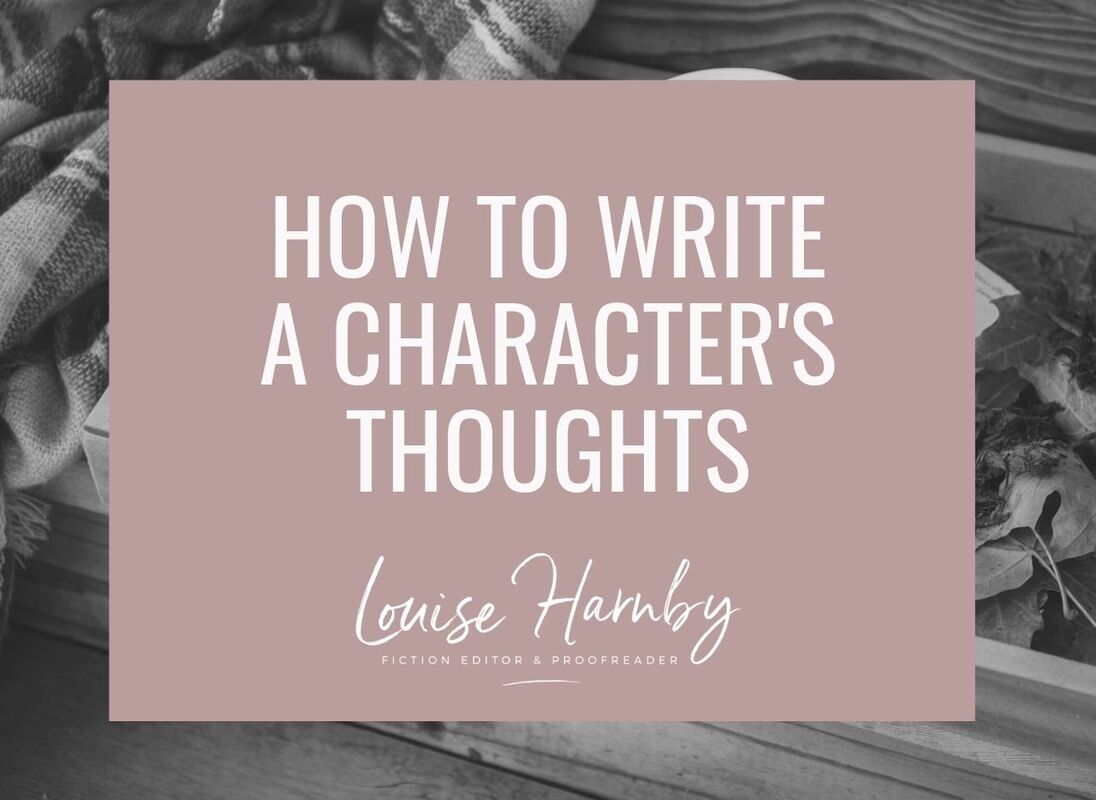|
If you write fiction, chances are your characters will be thinking. This article shows you several different ways of conveying what’s going on in their heads.
First off, there is no rule. Instead there are standard ways and not-so-standard ways of conveying thoughts in fiction.
Rules are problematic because they lead writers down a prescriptive road that can render their fiction difficult to read, and lacking in aesthetic on the page. Method 1: Quotation marks The Chicago Manual of Style (CMOS) has this advice (13.43: ‘Unspoken discourse’):
Thought, imagined dialogue, and other internal discourse (also called interior discourse) may be enclosed in quotation marks or not, according to the context or the writer’s preference. [...]
“I don’t care if we have offended Morgenstern,” thought Vera. “Besides,” she told herself, “they’re all fools.” This is undoubtedly my least-favourite option. I recommend you use the speech-mark style with caution. I can’t remember the last time I saw this approach used in commercial fiction coming out of a mainstream publisher’s stable. That doesn’t mean it hasn’t been, of course! I dislike it intensely, and many fiction publishers seem to be choosing other methods by preference, but those aren’t good reasons to avoid it. Your style is your choice. The best reason for avoiding it is that using speech marks could confuse your reader. The beauty of speech marks – or quotation marks – is that they indicate speech. When you put speech marks around a character’s thoughts, your reader will immediately assume they’re reading the spoken word. Look at the CMOS example above. Only when we hit thought Vera do we realize she’s not speaking at all. She’s thinking. Some authors might be tempted to use a different speech-mark style to indicate a thought. Again, this is confusing. Your reader might assume that you’ve not edited for consistency, as this example demonstrates:
“Jen, drop the knife. You’ll do yourself an injury.”
“No way. I’m not safe here, and nor are you.” Jen held the blade steady and looked around. ‘Crap. I need an exit,’ she thought. If, like me, you want something a little cleaner, something that won’t pull your reader out of the story because you led them down a speech-based garden path only to pull them up short at the gate, here are a few alternatives. Method 2: Italic text You can render your thoughts in italic text. For short thought streams, this is a common approach. Let’s return to the CMOS example and see what it looks like:
I don’t care if we have offended Morgenstern, thought Vera. Besides, she told herself, they’re all fools.
The advantages of this style are as follows:
However, some readers find that large chunks of italic strain their eyes. I’m one of them. I’m much more likely to skim over huge passages of italic because it’s not a pleasant reading experience. If that text is masking a clue, or a key character trait, information about an important event or something else that holds the plot together, it’s essential that the reader accesses it. Look at the Vera example again. There are two thought tags – thought Vera and she told herself – just to ram the point home that she’s thinking. Some readers and writers might consider two tags overkill, but they do help to break up the italic text and don’t jar as much as they might. But imagine if Vera’s thought stream had gone something like this:
I don’t care if we have offended Morgenstern, thought Vera. Besides, she told herself, they’re all fools. Those people at the bank, they don’t care a hoot for anyone but themselves. Like it’s their money they’re investing. We’ve trusted that bloody bank with our savings and look at what it’s got us. Nothing. Damn cheek. Vera put the letter back in the envelope and scowled.
That’s a lot of italic to get one’s retinas around. If you have a long stream of consciousness, you might prefer another method. Method 3: Normal body text This style forgoes speech marks and italic, and sticks to normal text. This is how it looks with the longer Vera example:
I don’t care if we have offended Morgenstern, thought Vera. Besides, she told herself, they’re all fools. Those people at the bank, they don’t care a hoot for anyone but themselves. Like it’s their money they’re investing. We’ve trusted that bloody bank with our savings and look at what it’s got us. Nothing. Damn cheek. Vera put the letter back in the envelope and scowled.
The advantage of this style is that it’s easy on the eye. However, some readers might be jarred by changes in tense. If your narrative is set in the past tense and set in the third person (as in this example with Vera) and you use the same text style for present-tense direct thoughts, then in a longer thought stream you could pull your reader out of the story. And if this happens frequently, your prose will be riddled with flip-flopping tenses that are at best frustrating and at worst confusing. Method 4: Free indirect style Another option is to use free indirect style (sometimes called free indirect discourse or free indirect speech). This style offers the essence of first-person thought but through a third-person viewpoint. The advantages of this style are as follows:
Let’s return to Vera to see how this works:
Vera didn’t care if they’d offended Morgenstern. Besides, they were all fools. Those people at the bank, they didn’t care a hoot for anyone but themselves. Like it was their money they were investing. Her family had trusted that bloody bank with their savings and look at what it had got them. Nothing. Damn cheek. Vera put the letter back in the envelope and scowled.
The free indirect style does keep the narrative distance close but it’s still not quite as immediate at the present-tense first person. So is there anything else we can do? Method 5: Mix it up A more creative option might be to combine direct and indirect thought styles. In the example below we begin with two sentences that use the italic style for the present-tense first-person thought, and we retain the thought tags to break up the text. Then we move into roman text but cast the thought stream in the free indirect style, which matches the main narrative: third-person past tense.
I don’t care if we have offended Morgenstern, thought Vera. Besides, she told herself, they’re all fools. Those people at the bank, they didn’t care a hoot for anyone but themselves. Like it was their money they were investing. Her family had trusted that bloody bank with their savings and look at what it had got them. Nothing. Damn cheek. Vera put the letter back in the envelope and scowled.
The advantages of this style are as follows:
Summing up As with many sentence-level decisions in fiction writing, rendering thoughts is about style choices rather than a single prescriptive rule. Choose the solution that fits your story best. This might mean making different decisions at various points in your novel depending on what’s going on. Consider combining approaches if you have longer thought streams and want to be sure of retaining reader engagement. And, finally, avoid speech marks when it comes thoughts. They’re called speech marks for a reason and are best reserved for talking and muttering! Cited works and related resources
Louise Harnby is a line editor, copyeditor and proofreader who specializes in working with crime, mystery, suspense and thriller writers.
She is an Advanced Professional Member of the Chartered Institute of Editing and Proofreading (CIEP), a member of ACES, a Partner Member of The Alliance of Independent Authors (ALLi), and co-hosts The Editing Podcast.
15 Comments
17/12/2018 09:37:56 am
"This might mean making different decisions at various points in your novel depending on what’s going on."
Reply
Louise Harnby
17/12/2018 04:51:37 pm
Just edited this reply because I realized I had two Method 4s. Sorry!
Reply
D M Costa
21/12/2018 12:20:31 am
A big THANK YOU to Louise, for this excelente post!
Reply
Louise Harnby
21/12/2018 02:15:17 pm
Glad you liked it, DM!
Reply
29/12/2018 06:18:48 pm
After much trial and error I have found what works best for my writing is to put a thought tag either in the middle of an interior thought sentence or at the end. I do this to every thought sentence that's written in first person to separate it from the third person narrative. In the instance of a longer interior monologue I write it as a long sentence with comma separations. I'm afraid if I leave an inner thought sentence by itself without a tag it'll confuse the reader.
Reply
Louise Harnby
29/12/2018 08:54:42 pm
Thanks for sharing your own method, Robert. Glad you've found what works for you and your readers - that's the most important thing!
Reply
Lindsey Russell
29/12/2018 10:10:28 pm
Excellent article again.
Reply
Louise Harnby
29/12/2018 10:26:09 pm
Thanks, Lindsey!
Reply
30/12/2018 07:19:07 am
Great article!
Reply
Louise Harnby
30/12/2018 10:41:51 pm
I bet the fact that you mix things up means it's more interesting for your reader. Thanks for sharing your preferred approach!
Reply
30/12/2018 09:32:22 pm
Thank you so much! I was just getting depressed, thinking, well, in the book I'm just about to go with my editor seemed fine with me using both italics and indirect.... and then I find that it IS fine! What a relief!
Reply
Louise Harnby
30/12/2018 10:45:17 pm
Hi, Jemima. Absolutely. Sometimes one approach will work better than another. It's all about flow and reader engagement. I don't like to see pro editors being too prescriptive about this. It's not about rules but about whether it's clear to the reader what your intention is. Glad your editor gets that too!
Reply
Cheryl Ann Fields
3/3/2023 11:53:17 pm
I am preparing my debut novel for publication and need guidance on the capitalization rules of a mid-sentence thought. I've been looking online and haven't found an answer. Here is my sample.
Reply
Louise Harnby
4/3/2023 04:21:50 pm
I'd handle it just as you have, Cheryl Ann.
Reply
Karen Roberts
27/6/2024 01:28:35 am
Hi Louise, I am using italics for thoughts which I agree I think make the most sense. However, I am just wondering, when writing thoughts, is it a rule that you need to say..... I hope I get an answer, thought Karen. If Karen has been talking and she is the main character, do I really need to say, Karen thought, or thought Karen, or wondered Karen etc... Can I just use italics without saying... 'thought'. Thanks.
Reply
Leave a Reply. |
BLOG ALERTSIf you'd like me to email you when a new blog post is available, sign up for blog alerts!
TESTIMONIALSDare Rogers'Louise uses her expertise to hone a story until it's razor sharp, while still allowing the author’s voice to remain dominant.'Jeff Carson'I wholeheartedly recommend her services ... Just don’t hire her when I need her.'J B Turner'Sincere thanks for a beautiful and elegant piece of work. First class.'Ayshe Gemedzhy'What makes her stand out and shine is her ability to immerse herself in your story.'Salt Publishing'A million thanks – your mark-up is perfect, as always.'CATEGORIES
All
ARCHIVES
July 2024
|
|
|
|

















 RSS Feed
RSS Feed





